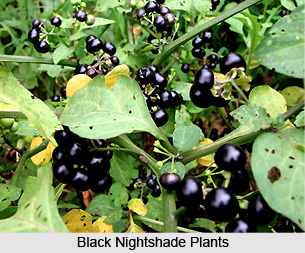 The black nightshade, also known as sunberry or `wonder cherry`, is a tiny upright and fine yearly herb. It forms an overspreading crest, grows dispersedly with several spreading branches upto 1 metre in height. The stems and branches are even and soft. The plant has alternating, egg-shaped, oval-shaped leaves; white, cream or violet flowers in bunch, purple or black fruit when matured, containing blue or black seeds.
The black nightshade, also known as sunberry or `wonder cherry`, is a tiny upright and fine yearly herb. It forms an overspreading crest, grows dispersedly with several spreading branches upto 1 metre in height. The stems and branches are even and soft. The plant has alternating, egg-shaped, oval-shaped leaves; white, cream or violet flowers in bunch, purple or black fruit when matured, containing blue or black seeds.
The black nightshade is indigenous to West Africa, but is now grown all over India as well.
A study of black nightshade or `manathakkali` leaves demonstrates them to consist of 82.1% moisture, 5.9% protein, 1.0% fat, 2.1% minerals and 8.9% carbohydrates per 100 grams. The minerals and vitamins present in it include calcium, phosphorus, iron, riboflavin, niacin and vitamin C. Its vital energy value is 68.
The plant and the fruit contain toxic alkaloid solanine and saponin. Feeding tests on sheep for toxicity, however, showed negative results.
Methods of usage
Black nightshade heals a variety of disorders in highly unlikely categories like- cardiac, urinal, inflammations, lung-malfunctions, fever and skin eruptions.
Healing Power and Medicinal Properties of black nightshade
The black nightshade is used as a vital component in numerous Indian medicines. It is a valuable cardiac vitaliser. It corrects troubled processes of nutrition by which the organism consumes, digests, absorbs, transports, utilises and excretes food substances, and rejuvenates the normal function of the system. It also lessens excitement, annoyance and ache.
The leaves of the plant are somewhat acrid, which becomes less noticeable after cooking. The fruits of the plant are of revitalising value and serve as an effective purgative. They also work as an appetiser.
Dropsy cured by black nightshade
The plant is useful in the treatment of dropsy. It boosts the secretion and discharge of urine. It can both be used as decoction or as a vegetable in the curing of this disease. An extract of the leaves and stem, in dosages of 6 to 8 ml., can also be consumed.
Fever cured by black nightshade
Manathakkali leaves are useful for fever. Syrup of the vegetable can be given as a soothing drink. To encourage ample perspiration, a hot concoction of 0.75 to 1.25 decigrams of dried leaves can be used. Fruits of the plant can also be administered with favourable results in fevers.
Stomach Disorders cured by black nightshade
The leaves are effective in the treatment of digestive problems. The unrefined juice of the leaves can be used separately or mixed with other juices or liquids. It is used in stomach disorders like flatulence, peptic ulcers and colitis. A concoction of the plant is useful in dysentery and other stomach illnesses.
Asthma healed by black nightshade
The plant helps in getting rid of catarrhal matter and phlegm from the bronchial tubes in asthma patients. The fruits of the plant can also be used constructively in treating asthma.
Skin Disorders healed by black nightshade
The plant is useful in acute skin diseases. The juice distilled from the plant should be given in dosages of 180 to 210 ml.
The juice can also be massaged locally on the affected parts in acute skin disease such as acne, eczema and psoriasis. As an anodyne or pain reliever, a decoction of the plant can be used for washing swollen, irritable and aching parts of the body.
A paste of the plant serves as a constructive applicant over caustic ulcers, pustules and suppurating syphilitic ulcers, brutal burns, herpes and rheumatic joints. Green fruits of the plant can be mashed and massaged locally on ringworms with satiating results. A juice or poultice of leaves can be effectively massaged on eruptive skin disorders, whitlow and burns.
Other Diseases healed by black nightshade
Hot leaves can be employed with satiating results over inflamed and painful scrotum and testicles. A juice or poultice of the leaves is an effective massage over rheumatic and gouty joints, caustic ulcers and tumours. A decoction of the leaves can be used to cleanse tumours and swollen, irritable and aching parts or the body.
Other Uses of black nightshade
Manathakkali leaves are prevalently used as a vegetable. The leaves mix well with other leafy vegetables and pulses. The juice of the leaves can be blended with mediums like coconut water, coconut milk, butter-milk, cow`s milk and fruit juice.



















